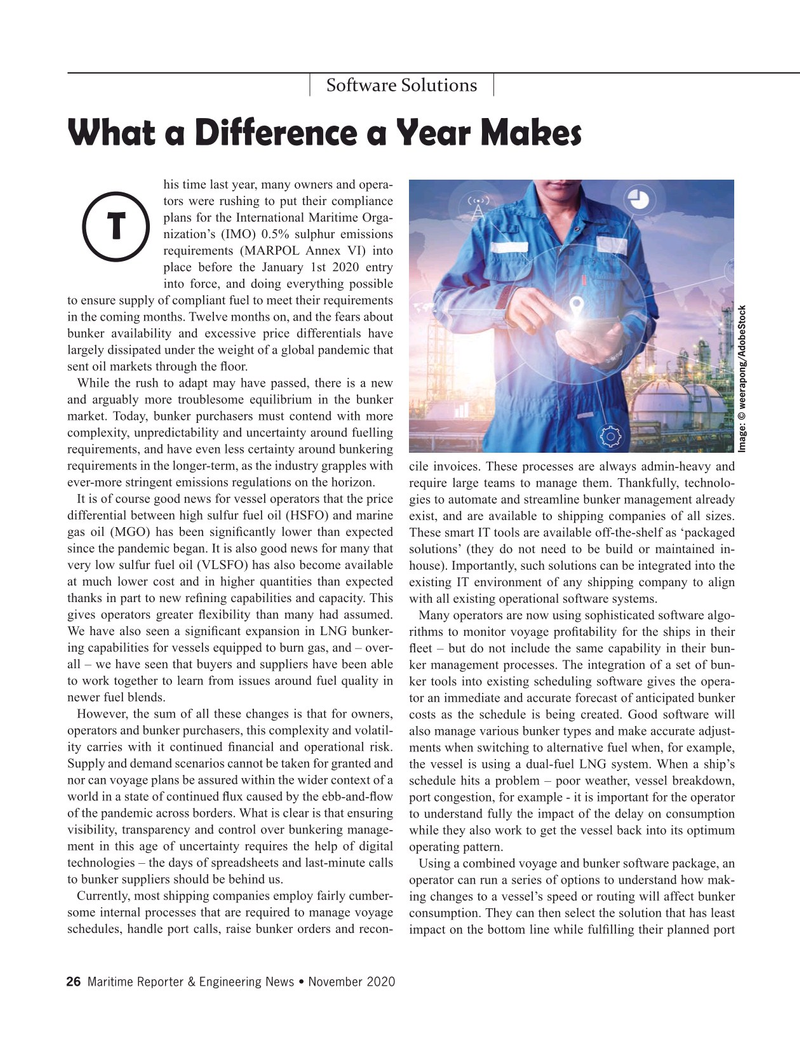
Page 26: of Maritime Reporter Magazine (November 2020)
Workboat Edition
Read this page in Pdf, Flash or Html5 edition of November 2020 Maritime Reporter Magazine
Software Solutions
What a Difference a Year Makes his time last year, many owners and opera- tors were rushing to put their compliance plans for the International Maritime Orga- nization’s (IMO) 0.5% sulphur emissions
T requirements (MARPOL Annex VI) into place before the January 1st 2020 entry into force, and doing everything possible to ensure supply of compliant fuel to meet their requirements in the coming months. Twelve months on, and the fears about bunker availability and excessive price differentials have largely dissipated under the weight of a global pandemic that sent oil markets through the ? oor.
While the rush to adapt may have passed, there is a new and arguably more troublesome equilibrium in the bunker market. Today, bunker purchasers must contend with more complexity, unpredictability and uncertainty around fuelling
Image: © weerapong/AdobeStock requirements, and have even less certainty around bunkering requirements in the longer-term, as the industry grapples with cile invoices. These processes are always admin-heavy and ever-more stringent emissions regulations on the horizon. require large teams to manage them. Thankfully, technolo-
It is of course good news for vessel operators that the price gies to automate and streamline bunker management already differential between high sulfur fuel oil (HSFO) and marine exist, and are available to shipping companies of all sizes. gas oil (MGO) has been signi? cantly lower than expected These smart IT tools are available off-the-shelf as ‘packaged since the pandemic began. It is also good news for many that solutions’ (they do not need to be build or maintained in- very low sulfur fuel oil (VLSFO) has also become available house). Importantly, such solutions can be integrated into the at much lower cost and in higher quantities than expected existing IT environment of any shipping company to align thanks in part to new re? ning capabilities and capacity. This with all existing operational software systems. gives operators greater ? exibility than many had assumed. Many operators are now using sophisticated software algo-
We have also seen a signi? cant expansion in LNG bunker- rithms to monitor voyage pro? tability for the ships in their ing capabilities for vessels equipped to burn gas, and – over- ? eet – but do not include the same capability in their bun- all – we have seen that buyers and suppliers have been able ker management processes. The integration of a set of bun- to work together to learn from issues around fuel quality in ker tools into existing scheduling software gives the opera- newer fuel blends. tor an immediate and accurate forecast of anticipated bunker
However, the sum of all these changes is that for owners, costs as the schedule is being created. Good software will operators and bunker purchasers, this complexity and volatil- also manage various bunker types and make accurate adjust- ity carries with it continued ? nancial and operational risk. ments when switching to alternative fuel when, for example,
Supply and demand scenarios cannot be taken for granted and the vessel is using a dual-fuel LNG system. When a ship’s nor can voyage plans be assured within the wider context of a schedule hits a problem – poor weather, vessel breakdown, world in a state of continued ? ux caused by the ebb-and-? ow port congestion, for example - it is important for the operator of the pandemic across borders. What is clear is that ensuring to understand fully the impact of the delay on consumption visibility, transparency and control over bunkering manage- while they also work to get the vessel back into its optimum ment in this age of uncertainty requires the help of digital operating pattern. technologies – the days of spreadsheets and last-minute calls Using a combined voyage and bunker software package, an to bunker suppliers should be behind us. operator can run a series of options to understand how mak-
Currently, most shipping companies employ fairly cumber- ing changes to a vessel’s speed or routing will affect bunker some internal processes that are required to manage voyage consumption. They can then select the solution that has least schedules, handle port calls, raise bunker orders and recon- impact on the bottom line while ful? lling their planned port 26 Maritime Reporter & Engineering News • November 2020
MR #11 (18-33).indd 26 11/9/2020 9:35:20 AM

 25
25

 27
27
